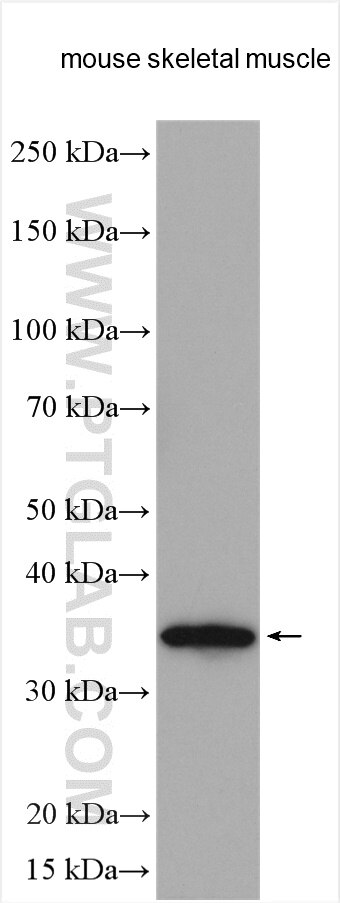Tested Applications
| Positive WB detected in | mouse skeletal muscle tissue |
Recommended dilution
| Application | Dilution |
|---|---|
| Western Blot (WB) | WB : 1:500-1:2000 |
| It is recommended that this reagent should be titrated in each testing system to obtain optimal results. | |
| Sample-dependent, Check data in validation data gallery. | |
Published Applications
| WB | See 1 publications below |
Product Information
28493-1-AP targets NMNAT1 in WB, ELISA applications and shows reactivity with Human, mouse samples.
| Tested Reactivity | Human, mouse |
| Cited Reactivity | human, mouse |
| Host / Isotype | Rabbit / IgG |
| Class | Polyclonal |
| Type | Antibody |
| Immunogen |
CatNo: Ag29584 Product name: Recombinant human NMNAT1 protein Source: e coli.-derived, PGEX-4T Tag: GST Domain: 52-152 aa of BC014943 Sequence: GDAYKKKGLIPAYHRVIMAELATKNSKWVEVDTWESLQKEWKETLKVLRHHQEKLEASDCDHQQNSPTLERPGRKRKWTETQDSSQKKSLEPKTKAVPKVK Predict reactive species |
| Full Name | nicotinamide nucleotide adenylyltransferase 1 |
| Calculated Molecular Weight | 33 kDa |
| Observed Molecular Weight | 35 kDa |
| GenBank Accession Number | BC014943 |
| Gene Symbol | NMNAT1 |
| Gene ID (NCBI) | 64802 |
| RRID | AB_3086056 |
| Conjugate | Unconjugated |
| Form | Liquid |
| Purification Method | Antigen affinity purification |
| UNIPROT ID | Q9HAN9 |
| Storage Buffer | PBS with 0.02% sodium azide and 50% glycerol, pH 7.3. |
| Storage Conditions | Store at -20°C. Stable for one year after shipment. Aliquoting is unnecessary for -20oC storage. 20ul sizes contain 0.1% BSA. |
Background Information
NMNAT1 is a member of the nicotinamide-nucleotide adenylyltransferases (NMNATs) which catalyze nicotinamide adenine dinucleotide (NAD) synthesis (PMID: 28445802). NMNAT is a central enzyme in NAD biosynthesis, catalyzing the formation of NAD+ from nicotinamide mononucleotide (NMN) and ATP (PMID: 17402747). NMNAT1 is widely expressed with the highest levels in skeletal muscle, heart, and kidney(PMID: 11027696). Mutations in NMNAT1 have been shown associated with the LCA9 form of the retinal degeneration pathology Leber's congenital amaurosis (PMID: 22842229, 22842230).
Protocols
| Product Specific Protocols | |
|---|---|
| WB protocol for NMNAT1 antibody 28493-1-AP | Download protocol |
| Standard Protocols | |
|---|---|
| Click here to view our Standard Protocols |




